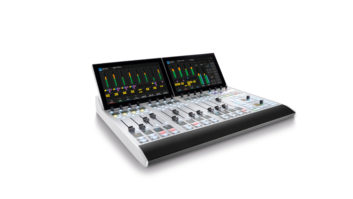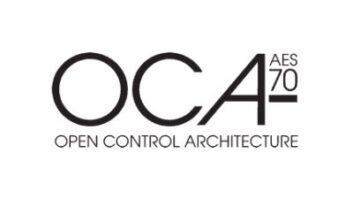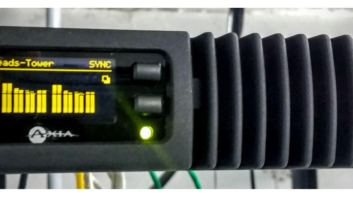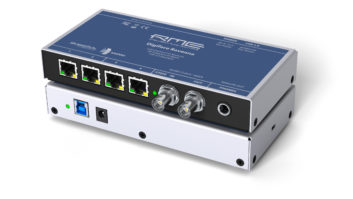
The author is vice president of sales, support and marketing at the Telos Alliance.
I know it’s hard to believe, but AoIP for broadcast is almost 20 years young.
The Telos Alliance first began its work on what became Livewire in 1999. As I sit down to write this article, I am struck by the amount of time we’ve been working on this tech, telling its story and selling it.
However, I’m most amazed at how widely and deeply it has been adopted over the years, especially considering the resistance to it on several fronts, including industry vendors who were deeply invested in 1960s-era time domain multiplex technology and who told customers AoIP wouldn’t work. The early adopter customers were trendsetters for sure.
Now AoIP is fully mainstream and almost no gear is sold that isn’t IP-capable — even if it only works at the edges of the network (although this is clearly not an ideal topology to take full advantage of all AoIP has to offer).
For those who are just joining the discussion, audio over IP uses commercial off-the-shelf IT hardware made popular by enterprise users to power businesses (data and voice-over-IP networks) and build audio networks for broadcast and media content facilities. Ethernet switches and other hardware that is commonly used to build traditional data networks for government, hospitals and Fortune 500 companies can be easily architected to route audio and other program associated data, as all are IP packets.
The advantage of such an approach is cost- and time-savings in building facilities, along with the flexible scalability and the self-healing properties of IP networks.
THE PATH TO UBIQUITY
AoIP has passed through three significant milestones to become so popular, including:
- Rapid adoption in radio studio facilities. The first real event to popularize AoIP was the adoption by radio facilities worldwide. Though Telos stood alone for a few years, other manufacturers have since developed AoIP products and helped customers understand the advantages of — and adopt — AoIP. Many AoIP studios have been built across the world and have proven the idea and the technology’s reliability.
- Creation of the AES67 standard. A big concern over interoperability of AoIP was addressed by the creation of the AES67 standard. Several manufacturers worked on a committee over a few years to iron out parameters for how audio should be shared amongst different AoIP equipment providers. Telos Alliance played a key role, including helping to underwrite the effort’s cost, but we also salute the work of Kevin Gross, who headed the committee; Andreas Hildebrand from ALC NetworX; and our own Greg Shay, who contributed at a very high level to this work. Now, the AES67 standard has leveled the playing field and is a standard that allows all AoIP AES67-compliant gear to interoperate, regardless of native protocol, which has in turn widened adoption.
- Creation of SMPTE ST 2110 standard. The final factor is SMPTE 2110. This suite of standards has been largely driven by the work of the Alliance for IP Media Solutions in an effort to adapt AoIP to the television production and transmission environment. ST 2110-30 is based on AES67 and was developed to make audio as compatible as possible with video. By using AES67, SMPTE 2110-30 allows audio equipment to work well with the rest of the 2110 suite. The television industry has fully bought-in and has accelerated adoption, which will power next-gen TV solutions like ATSC 3.0.
FOUNDATION FOR THE FUTURE
As Telos founder Steve Church was fond of saying, “When it’s all IP there are no limits …” The future is intriguing to the people we talk to every day, with AoIP serving as that future’s foundation.
Here’s one example: Consider that transmission sites in many parts of the world now have IP-based connections between studio and transmitter via low-cost Ethernet radio systems, MPLS or similar so that linear and bandwidth-efficient AoIP studio transmitter links are now proliferating with advantages, including higher-quality audio paths, lower cost, higher flexibility and greater monitoring and audio/data exchange capabilities. Our new Omnia MPX Node will transmit a full stereo composite signal with RDS at data rates as low as 320 kbps.
Another popular option is the nontraditional console. A console can now be a tablet or touchscreen with or without the actual traditional surface. The “screen-based” console provides the ability to heavily customize the user interface for an individual or show. The operator can also move around inside or outside the traditional studio to create the best broadcast on their terms, as opposed to being tethered to a console. Broadcasters have much more flexibility when doing remotes and the like.
The infrastructure options are also very interesting: No longer are facilities forced into using the traditional approach of assembling a group of purpose-built boxes connected via analog wiring, AES3 or even the preferred method using AoIP. We can use combinations of hardware and software as needed.
We are unlocking the software from the boxes to allow them to run in virtual environments, taking full advantage of the efficiencies and redundancies that the IT industry has brought to the rest of the world. Telos Alliance now has several products running in virtual machine environments, which we enjoyed showing visitors at NAB Show 2019.
[Are You Up to the Challenge?]
This said, we remain committed to continuing to produce world-class hardware products because the same innovations we offer today and are working on for tomorrow can be easily be made available across our full range of hardware and software offerings.
Next-generation topology, again leveraging best practices in IT, allows efficient use of IT hardware and offers great reliability and redundancy for 24/7/365 applications. The options are plentiful as the audio paths for even the most basic radio and TV facilities grow in complexity as streaming, ad insertion, OTT and other game-changing business opportunities are presented to broadcasters.
Rack rooms can be smaller and require less cooling and conditioned power, yet accomplish more per square foot. There is even the potential for pieces of the station’s infrastructure to actually locate in the cloud — very attractive for larger group broadcasters that share common systems amongst all their network or affiliate stations. Both noteworthy and comforting, this tech is proven and can scale to magnificent proportions, yet can be eased into one studio at a time for those who have smaller projects.
So while we’ve come a long way since those early days when we were developing the first AoIP protocol for broadcast in our labs 20 years ago, AoIP is just now gaining full steam for the radio industry, and the TV industry is following suit. But more importantly, it is the substrate upon which all future facility operations and standards exist, whether they are physical or virtual. The future for AoIP is bright indeed, and we, for one, are excited to be a part of it.












